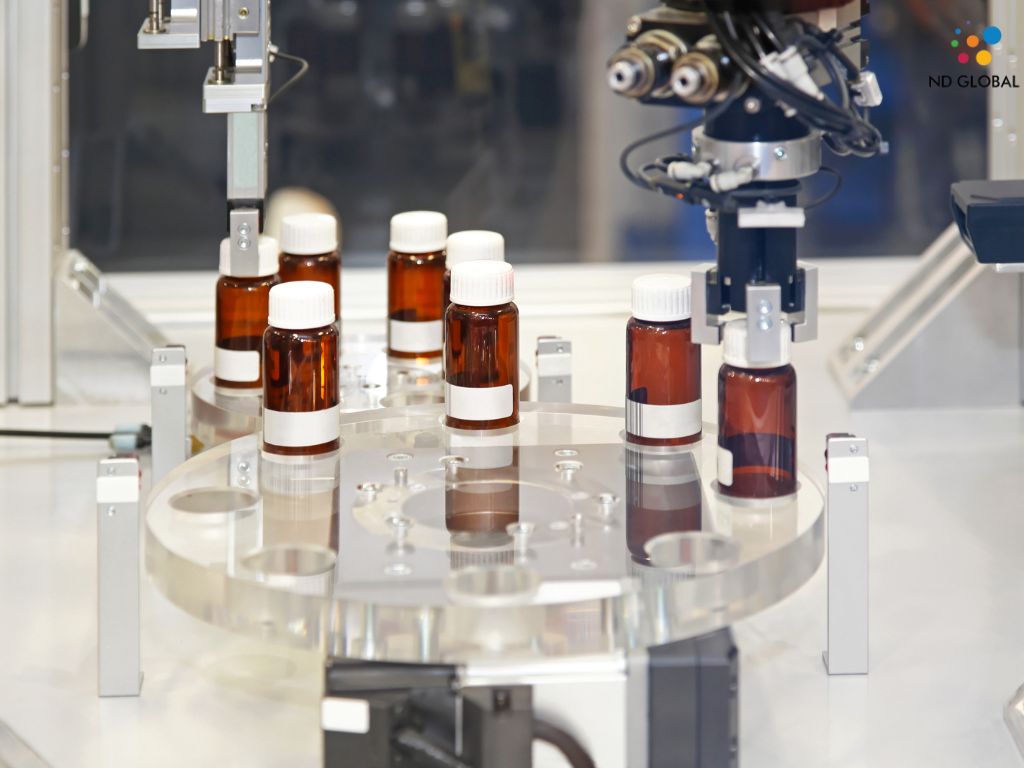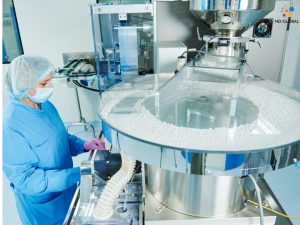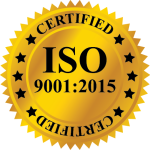Gummies, effervescence, soft gels, tablets, capsules, small molecules, and pills. These are known as oral solid dosage (OSD) forms, which are final drug product therapies that are swallowed, dissolved in the digestive system, and absorbed into the bloodstream to give the medication to the body. The first thing most people picture when they think of medicine is a tiny white pill or maybe an orange bottle filled with them. The widespread use of oral solid dosage (OSD) medications—whether in the form of pills, tablets, capsules, soft gels, effervescence, gummies, or any other variation—remains at the forefront of the market, despite recent considerable advancements in biologic therapy and various parenteral. Because of its widespread use, OSD is a critical component of the pharmaceutical sector and is especially vulnerable to new trends and market dynamics.
Solving Issues Impacting Tooling in Tablet Production
- Getting out of a difficult circumstance – Granule accumulation on the punch-tip face, or sticking, is the most frequent issue encountered throughout manufacturing. If handled promptly and efficiently, it may help output and raise expenses. There are numerous causes for sticking. It may be brought on by several variables about the formulation’s physicochemical qualities, the punch face’s surface features, and tablet press problems. Environmental factors like humidity and temperature could cause issues. The cohesive forces holding the tablet together and the adhesive forces between the formulation’s constituents and the tablet tooling material can significantly impact the sticking point. Sticking will happen if the adhesive details are more significant than the cohesive forces. The conditions in which the tablet is made and the method used to prepare the formulation are two examples of variables that can impact adhesive forces. The role that the environment plays in the synthesis of ibuprofen is a prime example. Because the ibuprofen API has a relatively low melting point, high manufacturing temperatures may hurt the tablet. Sticking is less likely when the room temperature is lowered where compression occurs. Another factor that affects sticking risk is humidity. If there is excessive humidity in the formulation preparation and storage facilities or the compression chamber, moisture may find its way into the production process. Higher stickiness may be correlated with more incredible wetness. If the granulation being squeezed is moist, the issue may get worse. Excessive moisture within the tablet might intensify adhesive tensions because of the increased capillary action between the granule and the tooling surface. Sticking occurs when capillary bridges form and vital adhesion areas result. Sticking can also be affected by cohesive forces. These include electrostatic forces, which occur when a granule is dehydrated and generates static electricity, capillary action brought on by high moisture content, and Van der Waals forces, which are the attraction of intermolecular forces between molecules. Applying anti-stick tool coatings and treatments is one practical approach that is successfully used. Still, any sticking issue requires careful research before finding a solution. In any situation, advanced anti-stick coatings maintain a low adhesive force. The coating is hydrophobic or less hydrophilic than other coatings, so if the adhesion forces are insufficient to start and the elemental composition of the coating does not draw the formulation, they will stay low. A professional must select the best coating for the work; to reduce sticking and increase production, a tooling expert can match a particular formulation to the tool coating.
- Boosting output – Another issue with mass-producing tablets is finding a rapid and economical way to increase production capacity. Multi-tip tooling is the best way to handle this. Multi-tip tooling is not a new technology, but the pharmaceutical sector has recently begun using it extensively. It has revolutionized mass manufacturing and is currently regarded as the most efficient method of producing tablets in applications where it is applicable. The effective use of multi-tip tooling might lessen the need to make the costly capital investment of purchasing additional tablet presses. Additionally, it reduces the quantity of tool setups needed for each manufacturing batch. Additionally, each set is finished faster, cutting down on the total time required for production. Multi-tipped punches can be used with practically any tablet press, but before investing, it’s crucial to examine a few essential points, such as the following:
- Is the tablet press operating effectively? Examine the turret area for wear. To avoid harming the punch heads, replace the cams if there are indications of severe wear or deterioration.
- Can many tips be used with this press? The upper turret needs a keyway in the guide to guarantee alignment with the tooling.
- The feeder paddles must be adjusted to guarantee that the formulation amount is appropriate for die-filling. Additionally, higher manufacturing volumes must be supported by the tablet ejection system.
- Think about compressing the particle size and formulation. There may be issues if the granulation moves slowly enough. Reducing machine speed to give fill time or adjusting the feeding mechanism to maximize press speed can be beneficial. Go over your tablet design again.
- Most tablet designs can be created with several tips, although press and tool-type capabilities impact manufacturing. Ensure all aspects (such as form, size, profile, and embossing) are considered and utilize a design created especially for a multi-tip arrangement.
- Keeping your equipment in order – The state of a tool can significantly affect production and lead to several issues if maintenance protocols are not adequately followed. Production will be impacted by means out of commission because of preventable damage or unplanned replacement. An organized maintenance process can reduce frequent tablet and tooling issues. By implementing best practices in tool maintenance, tablet makers will ensure that the maximum life from tablet tooling is attained. A standard operating procedure (SOP) consisting of seven steps can be followed as an easy way to ensure maintenance operations are finished. Cleaning punches and dies is the first and most crucial step in removing any residue, preventing product contamination, and preventing problems like sticking. Next, evaluate the tooling to confirm the cleaning procedure and look for wear, corrosion, or damage indications. If damage is discovered, make the necessary repairs. Tooling damage, corruption, and light surface wear can all be fixed and polished back to a functional state. After completing this step, measure the tooling to ensure the dimensions have been kept within a reasonable working tolerance. Next, polish the tooling to ensure it is kept to a smooth finish, which will help extend its life and lessen issues like sticking. The following action lubricates the tools to safeguard, maintain, and facilitate seamless functioning. Lastly, take care when storing and moving punches and dies to prevent deterioration. Energies and parts that are in good condition, within specification, and ready for production are guaranteed by a coordinated tooling SOP. Moreover, consider using a tooling management system to ensure practical, systematic, and comprehensive tracking of tablet manufacturing. To get the most life out of punches and dies, this system can maintain track of tool maintenance and give a complete audit trail on tool usage.
- Spend money on training – Manufacturers should consider the technological know-how and skills gaps in the workforce while producing tablets effectively, as these factors can affect the bottom line. The output and caliber of the final product decrease with staff competence levels. There are adaptable, web-based classes available that are intended to recognize and tackle typical issues that arise in the manufacturing of contemporary tablets. Training is a crucial tool for ensuring that employees are competent in their jobs and capable of troubleshooting problems with ease, as well as for swiftly bringing them up to speed with new developments in pharmaceutical manufacturing. Ultimately, learning investments will lead to optimized tablet production.
Conclusion – Addressing common challenges in solid oral dosage (OSD) manufacturing, such as tablet production issues, output optimization, equipment maintenance, and workforce competence, is essential for ensuring efficient and high-quality pharmaceutical production. Adopting multi-tip tooling emerges as a revolutionary solution to boost production capacity, reducing the need for additional investments in tablet presses and streamlining the manufacturing process. However, carefully evaluating tablet press functionality and compatibility with multi-tip tooling is crucial for success. In the ever-evolving landscape of pharmaceuticals, a comprehensive approach to troubleshooting, optimization, and training is essential to meet market demands, maintain product quality, and contribute to the overall success of oral solid dosage manufacturing in the pharmaceutical sector.
How ND Global can help – ND Global can play a vital role in staffing for Solid Oral Manufacturing by providing specialized services that address the unique needs and challenges of the pharmaceutical industry. Here’s how ND Global can assist in staffing for Solid Oral Manufacturing:
- Specialized Recruitment: ND Global can leverage its expertise in pharmaceutical staffing to identify and recruit skilled professionals with experience in Solid Oral Manufacturing. This includes hiring experts in tablet production, tooling, equipment maintenance, and other critical areas.
- Industry Knowledge: ND Global’s understanding of the pharmaceutical sector allows them to source candidates with the specific skills and knowledge required for OSD manufacturing. This ensures that the recruited staff is well-equipped to tackle the challenges associated with tablet production, equipment maintenance, and optimization.
- Training and Development: ND Global can provide training programs to enhance the skills of existing staff or new hires. These programs can cover the latest advancements in pharmaceutical manufacturing, troubleshooting techniques, and best practices in OSD production. Well-trained employees contribute to improved efficiency and product quality.
- Strategic Staffing Solutions: ND Global can offer flexible staffing solutions to meet the dynamic needs of Solid Oral Manufacturing. Whether a company needs temporary staff for a specific project or permanent hires to fill critical roles, ND Global can tailor its staffing solutions accordingly.
- Compliance and Regulations: The pharmaceutical industry is highly regulated, and compliance with industry standards is crucial. ND Global can ensure that the recruited staff is well-versed in regulatory requirements, contributing to the production of pharmaceuticals that meet the highest quality and safety standards.
- Continuous Support: ND Global can provide ongoing support to its clients by staying informed about industry trends, technological advancements, and changes in regulations. This ensures that the staffing solutions provided remain relevant and aligned with the evolving needs of Solid Oral Manufacturing.
- Global Reach: ND Global’s reach extends beyond regional boundaries, allowing them to tap into a global talent pool. This is particularly beneficial for pharmaceutical companies with international operations or those looking to diversify their workforce.










